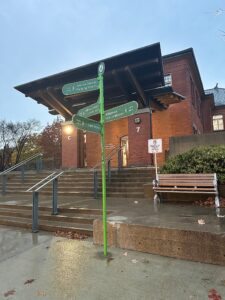

Humber’s Sustainability Trail highlights green initiatives, but some say it’s not enough
EnvironmentEtobicokeHumberNews Nov 23, 2023 Oleksandra Chorna

Humber has launched a Sustainability Trail initiative designed to spread awareness about Humber’s environmental work among students.
The Sustainability Trail is a series of signs, placed all over Lakeshore and North Campuses, containing information about the college’s green efforts on all fronts — from educational to operational.
According to Tessa Soltendieck, Humber’s Sustainability Manager, the college has been considering this idea for about six years, prior to the official launch.
“It was thought of because we saw a greater need for increasing the visibility of sustainability across the institution. We wanted to help create a culture of sustainability. And I think part of that involves creating kind of like a curiosity and an awareness of all the different things that Humber is doing to become a more sustainable campus,” says Soltendieck.
According to her, the format of the project — a number of green signs around campuses — is deliberate. She says that physical plaques are supposed to be noticeable and eye-catching to students, urging them to stop and read about some sustainable initiatives the college currently has.
Soltendieck cites Humber’s solar panels, which are the subject of one of the signs. It explains how many panels the college has, the amount of energy Humber avoids using because of them, and how many homes they can power. There’s also a Green Roof initiative plaque that talks about how this project helps reduce air pollution and increase biodiversity.
She highlights the sustainability team tried to create text for these signs that is both concise and informative. They wanted to make sure they told students everything they needed to know about the given environmental initiative and its positive impact, while also not boring them with long reads.
“The balance was incorporating a description of what the sustainability initiative was, how it would impact the environment, but also making it short enough so that people are gonna stop in their tracks and actually read it,” says Soltendieck.
According to Spenser Wood, the Director of Facilities Management, the signs also include information about the UN’s Sustainable Development Goals and how each Humber’s initiative meets them.
“There are 17 Sustainable Development Goals from the UN. And there’s one for water, one for energy and one for education. There’s a number of different ones. And so it’s relatively easy to match anything we’re doing to one or more of those sustainability goals. So they’re actually on the sign in a little box in the corner. It’s one of the things that goes across the world, really, on how people measure their sustainability. So we’re trying to align our efforts to that strategy, or at least show how it aligns,” says Wood.
He says this initiative aims to help students be environmentally conscious in their future careers.
“If we can educate students on various things that we might be doing, perhaps they will carry that knowledge to their future careers. Now that might have a much bigger impact on the world and on sustainability in general than just Humber’s own physical impact. So education, to our mind, is just as important as, what we actually built,”, says Wood.
But despite the Sustainability department’s efforts, many students simply aren’t aware of this project.
Jaqueline, a first-year Film and Media Production student at Humber says the plaques aren’t enough, as many people, including herself, often don’t notice them. She says students lack in-person time with the Sustainability team, in order to be aware of initiatives like this.
“Go to classes and talk to students to spread awareness about your projects. Organizing events and presentations with different speakers would be also a good way to engage students in learning more about sustainability,” says Jacqueline.
Rama, a Humber student who takes English language courses, shares Jaqueline’s opinion.
“Maybe they should spend more time with students, talking to them and doing surveys about how effective their projects are. Because, honestly, I never noticed those (sustainability) signs before.”.
And though the Sustainability department sometimes hosts events, most information about their initiatives is online. For those who want to explore the Sustainability Trail, there’s a Campus Compass app, which has a map of all plaques across Humber.









